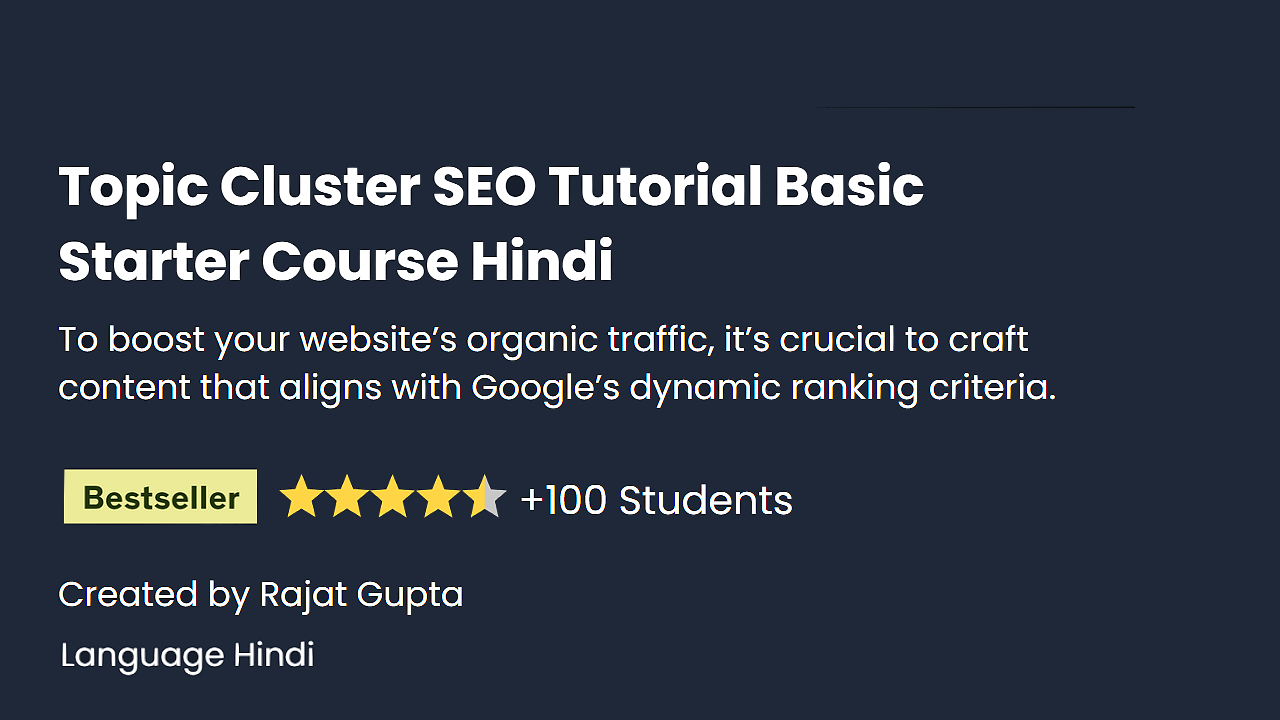Topic Cluster SEO Trends Best Practices 2025
Topic Cluster SEO, a content strategy that helps websites organize content around central themes to enhance relevance, improve ranking, and increase traffic. Read more about Topic Cluster SEO Trends Best Practices 2025
Topic Cluster SEO Trends Best Practices 2025
So as per this Topic Cluster SEO Trends Best Practices 2025 article, In the ever-evolving world of SEO, staying ahead of trends is key to driving organic traffic and maintaining a competitive edge.
One of the most powerful strategies for 2025 is Topic Cluster SEO, a content strategy that helps websites organize content around central themes to enhance relevance, improve ranking, and increase traffic.
In this Topic Cluster SEO Trends Best Practices 2025 comprehensive guide, we’ll explore Topic Cluster SEO in-depth, explain its importance, and provide the best practices for leveraging it in 2025.
What are Topic Clusters?
So based on this Topic Cluster SEO Trends Best Practices 2025 article, A Topic Cluster is an SEO strategy that organizes content into related groups, making it easier for search engines like Google to understand the structure of your website.
The central piece of Topic Cluster SEO 2025 How It Boosts Website Traffic topic cluster is a pillar page—a comprehensive, authoritative page that covers a broad topic. Surrounding it are several cluster content pages, each covering more specific aspects of the topic, linking back to the pillar page.
So as guided in this Topic Cluster SEO Trends Best Practices 2025 article, For example, if your pillar page is about SEO strategies, the cluster pages might cover topics like On-Page SEO, Link Building Techniques, Keyword Research Tools, and so on. The goal is to create a network of content that links together, signaling relevance and authority to search engines.
Why Topic Cluster SEO is Crucial in 2025
So according to this Topic Cluster SEO Trends Best Practices 2025 article, As search engines evolve, they are placing more emphasis on content relevancy and user intent. The goal is to understand the context of the search query and provide the most relevant content. Topic clusters make this possible by organizing content in a way that is both user-friendly and search engine-friendly.
With Google’s evolving algorithms, especially with the introduction of BERT and MUM (Multitask Unified Model), understanding the intent behind queries has become a top priority. Topic clusters help Google understand the relationship between your content, which can boost your visibility in search results.
Benefits of Topic Clusters for SEO in 2025
1. Improved Site Architecture
So considering this Topic Cluster SEO Trends Best Practices 2025 article, Master Topic Cluster SEO for Better Ranking in 2025 help organize your site content in a way that is logical and easy for both users and search engines to navigate. It ensures that your content is interconnected, allowing Google to crawl and index your pages more efficiently.
2. Enhanced Keyword Targeting
By structuring content in clusters, you can focus on a primary keyword for the pillar page while targeting more specific, long-tail keywords for the cluster pages. This approach increases your chances of ranking for a wider variety of keywords.
3. Higher Domain Authority
Search engines give more weight to authoritative pages. The pillar page, which is comprehensive and linked to by several cluster pages, can help you establish domain authority. As your cluster grows, so does the overall authority of your website.
4. Better User Experience
But Why Topic Cluster SEO is Essential for 2025 Success, With topic clusters, visitors can easily navigate between related content. It improves engagement, reduces bounce rates, and increases the likelihood of users returning to your site.
How to Build Effective Topic Clusters for SEO in 2025
Step 1: Choose a Broad Topic for the Pillar Page
Your pillar page should cover a broad, overarching topic relevant to your audience and business. For example, if you run a fitness blog, your pillar page might be “Complete Guide to Fitness” or “SEO for Beginners.” The key here is to choose a topic that is both relevant and has the potential to attract a large audience.
Step 2: Identify Related Subtopics for Cluster Content
Once you’ve identified your pillar page, you’ll need to create a list of subtopics that are related to it. These subtopics will form your cluster content. For our fitness blog example, cluster topics might include:
- Strength Training for Beginners
- The Best Exercises for Weight Loss
- How to Build Muscle Fast
- Nutrition Tips for Fitness Enthusiasts
Make sure these topics are highly relevant and reflect what users are searching for. Use tools like Google Keyword Planner, Ahrefs, or SEMrush to find keywords that have high search volume and low competition.
Step 3: Create High-Quality Content for Each Cluster Page
Each cluster page should be a detailed, high-quality piece of content that dives deep into the subtopic. This content should:
- Be well-researched and comprehensive.
- Include images, infographics, or videos for better engagement.
- Have a clear call to action (CTA) to encourage readers to explore other content on your site.
Step 4: Link Cluster Pages to the Pillar Page
Ensure that each cluster page links back to the pillar page, and vice versa. This internal linking strategy helps search engines understand the relationship between pages and boosts the SEO value of both the pillar and cluster pages.
Step 5: Optimize for User Intent
When creating content for your topic clusters, focus on user intent. Understand what users are looking for when they search for a specific topic and tailor your content to meet that need. The more you align with user intent, the higher the chances of ranking well in search results.
Topic Cluster SEO Best Practices for 2025
1. Use Advanced Keyword Research
Effective keyword research is the foundation of any successful topic cluster strategy. In 2025, it’s not enough to simply target primary keywords. You need to dive deep into long-tail keywords, related questions, and LSI (Latent Semantic Indexing) keywords to cover every aspect of your topic.
2. Create Evergreen Content
Your pillar pages should be evergreen content—information that remains relevant over time. In 2025, creating timeless content is more important than ever, as it keeps attracting traffic long after publication. For example, a “Beginner’s Guide to Digital Marketing” will continue to be valuable to new marketers for years to come.
3. Leverage Video Content
Video content is becoming increasingly important for SEO in 2025. Consider adding video to your pillar and cluster pages to improve engagement and provide a more interactive user experience. Google loves multimedia content, and it often gets ranked higher in search results.
4. Optimize for Featured Snippets
Featured snippets are a highly sought-after spot on Google’s search results page. To optimize for them, provide concise answers to common questions at the beginning of your cluster content. Use bullet points, numbered lists, and tables to increase your chances of appearing in the snippet section.
5. Improve Mobile Optimization
With mobile-first indexing becoming the norm, ensure your topic clusters and pillar pages are mobile-friendly. This includes optimizing your page load speed, ensuring responsive design, and making sure all elements are easy to navigate on smaller screens.
6. Use Schema Markup
Implement schema markup to help search engines understand the context of your content. This can increase your chances of appearing in rich snippets and improve visibility in search results. Schema markup also makes it easier for Google to display your content in features like “People Also Ask” or knowledge panels.
7. Regularly Update and Refresh Content
SEO trends and best practices evolve, and so should your content. Regularly updating your pillar and cluster pages with new information will help you maintain high rankings and relevance. Google favors fresh, updated content, especially in rapidly changing industries.
Topic Cluster SEO Tools for 2025
Several tools can help you implement a topic cluster SEO strategy:
- Ahrefs: For keyword research and backlink analysis.
- SEMrush: To track rankings, perform site audits, and identify content gaps.
- Surfer SEO: A great tool for content optimization and structure.
- Answer the Public: To discover common questions around your topic.
Conclusion About Topic Cluster SEO Trends Best Practices 2025
As we look toward the future of SEO in 2025, topic clusters will continue to be a vital part of any successful strategy. By creating a logical structure for your content, improving internal linking, and focusing on user intent, you can enhance your SEO performance and rank higher on search engines.
Don’t just aim for ranking higher—aim for becoming a trusted authority in your niche. By embracing the power of topic clusters and following the best practices outlined in this guide, you’ll be well-equipped to succeed in the world of SEO in 2025 and beyond. So this concludes the article about Topic Cluster SEO Trends Best Practices 2025!

